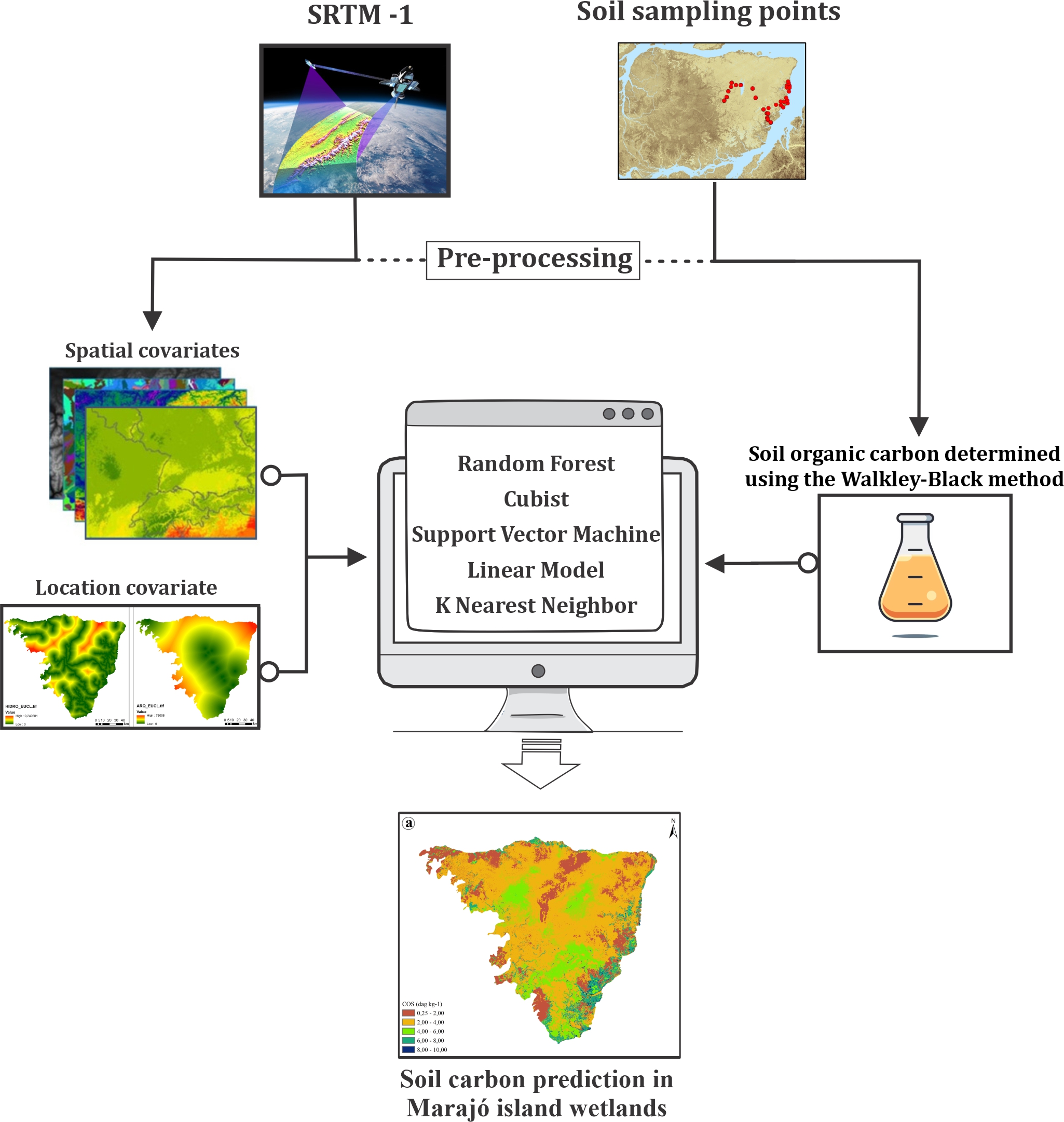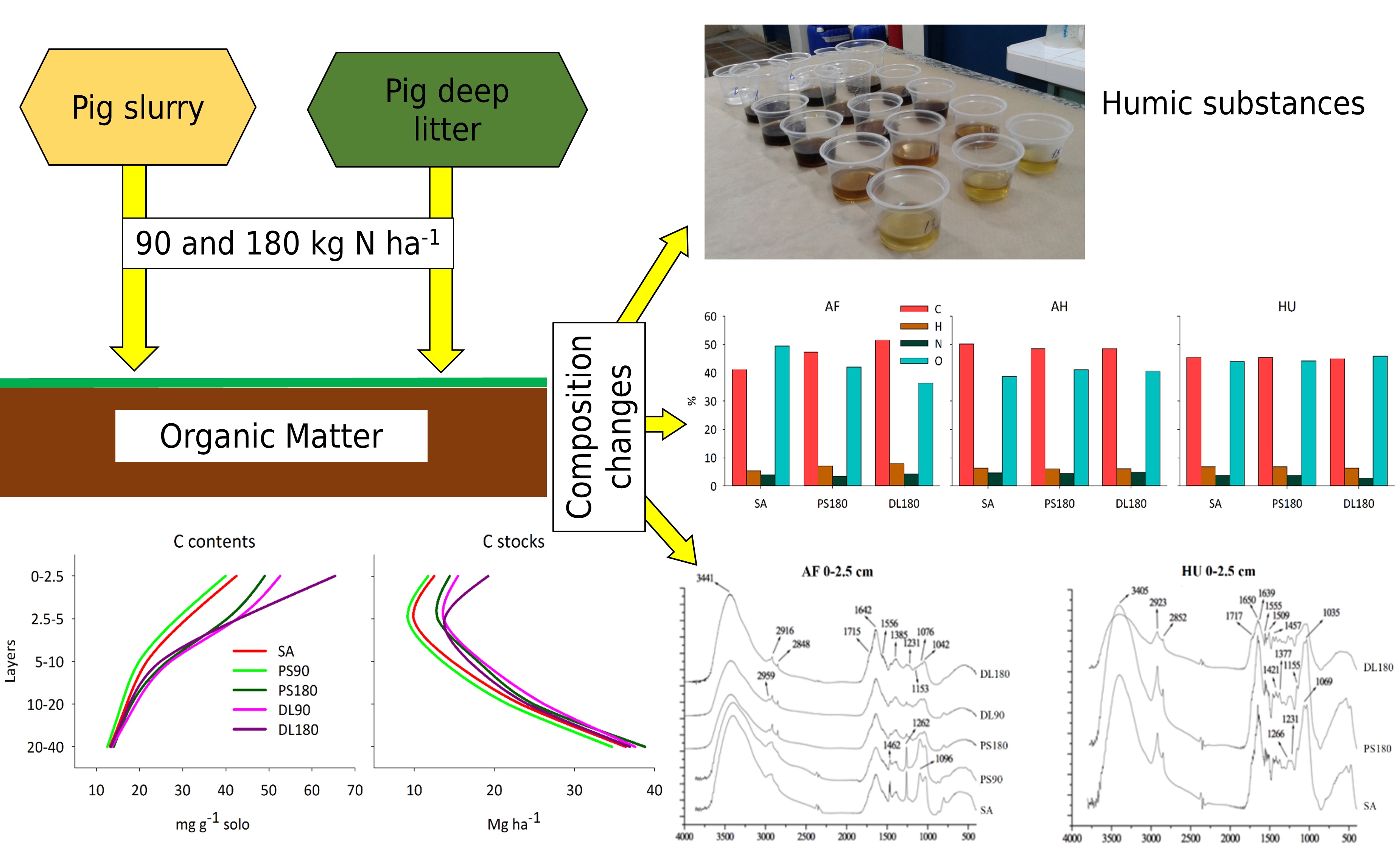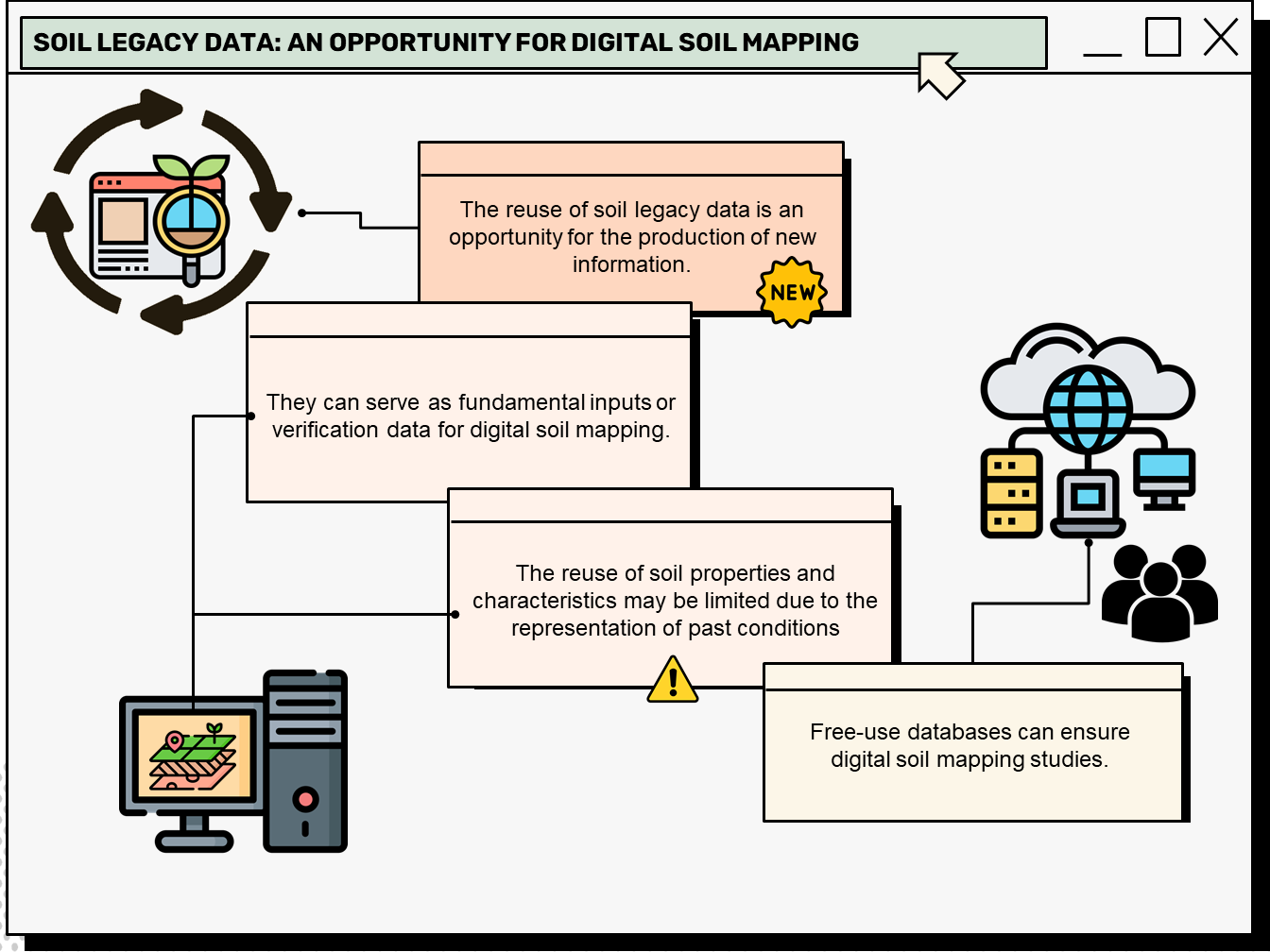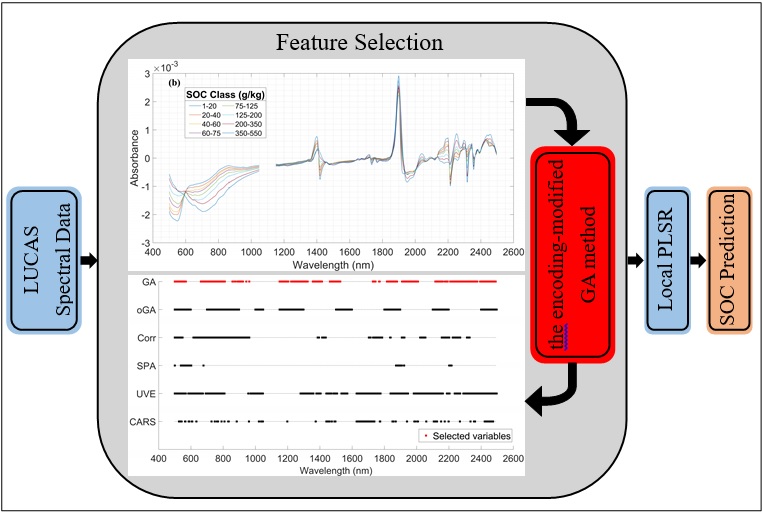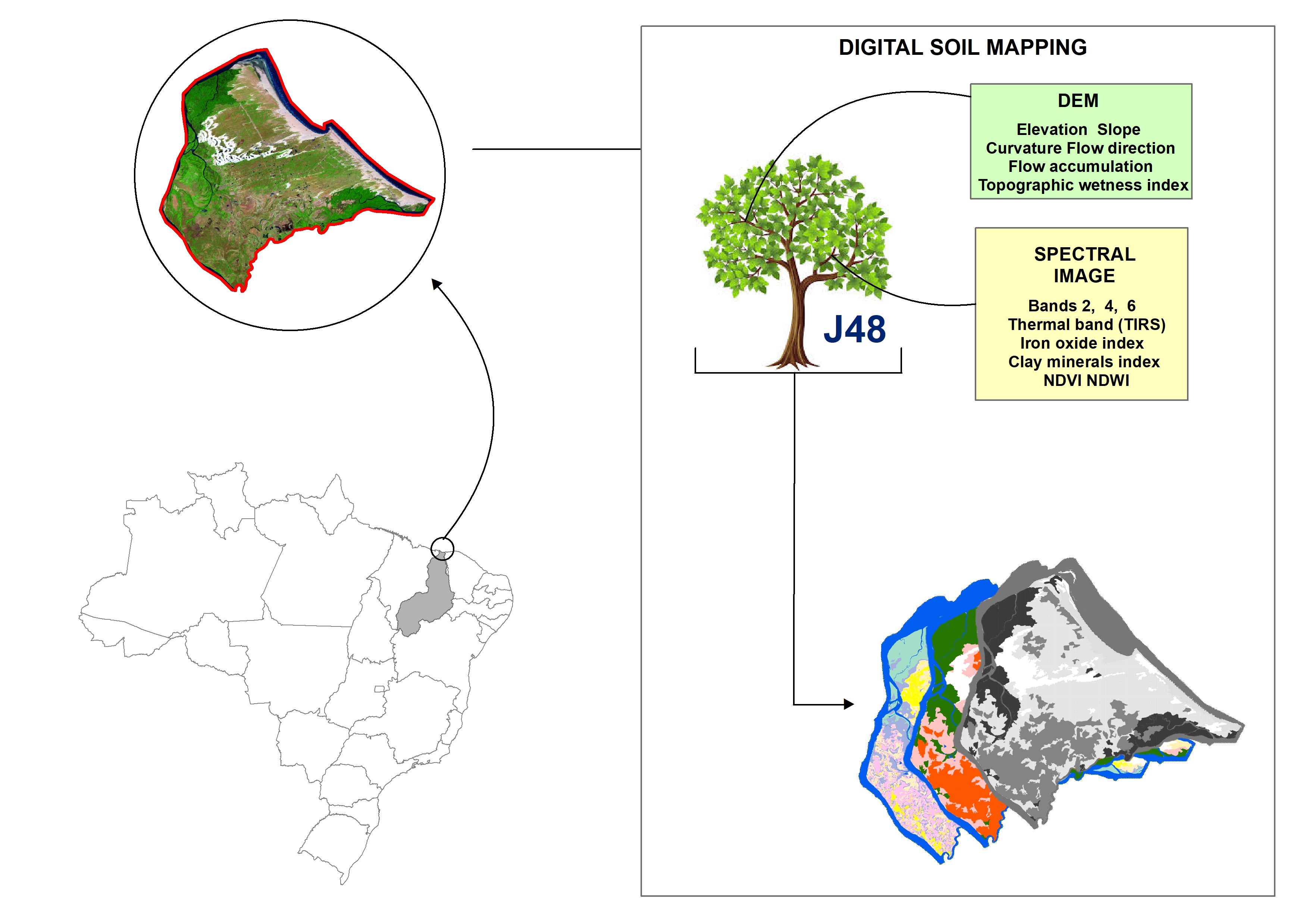Chemical and mineralogical constitution of redoximorphic features and mechanism of formation of Plinthosols from the Araguaia River plain, Brazil
11/Oct/2024
ABSTRACT Currently in Brazil, large grain cultivation projects on Plinthosols are a reality, however, there is little or no knowledge of the real mechanism of formation of the plinthite feature, in addition to what is reported in the literature as being a product of oxidation-reduction processes of iron element. This study evaluates iron redoximorphic features and investigates their chemical and mineralogical composition in two profiles of Plinthosols from the Araguaia River plain (P1 and P2). The study strengthens the understanding […]
Soil carbon prediction in Marajó island wetlands
27/Aug/2024
ABSTRACT Soil is an important carbon repository in terrestrial ecosystems, serving a fundamental role in the intricate cycling of this elemental component. Wetlands are crucial components of the global carbon cycle, playing a significant role in carbon sequestration due to their remarkable productivity and unique sedimentary structures. Our study focuses on the wetlands east of Marajó island, recognized as the largest fluvial-marine plain in South America. In this study, we applied a methodological framework to optimize SOC content prediction in […]
Chemical and spectroscopic composition of humic substances in soil subjected to pig manure applications for ten years
27/Aug/2024
ABSTRACT Application of pig manure (PM) in agriculture can influence the amount and composition of soil organic matter (SOM). This study evaluated the changes in contents and stock of C in chemical fractions of SOM and the chemical and spectroscopic composition of humic substances (HS) in a Typic Hapludult (Argissolo Vermelho-Amarelo) after ten years of PM application. Experimental area received 90 and 180 kg ha-1 of N in the form of pig slurry (PS90 and PS180) and pig deep litter […]
Soil legacy data: An opportunity for digital soil mapping
23/Jul/2024
ABSTRACT Soil legacy data is past information on soils available from various sources (e.g. survey reports and maps). When compiled and organized, data obtained through historical retrieval can be used as basic input or validation data for digital soil mapping. A bibliometric analysis of this topic can reveal research patterns, evolution, and scientific contribution, thus mapping the science produced in a specific period and determining the trend in research topics based on search terms. This article presents the characterization of […]
Multifractal and joint analysis of soil arthropod diversity in the Brazilian Savanna
12/Jul/2024
ABSTRACT Soil fauna organisms participate in a series of processes that benefit the physical and chemical soil properties; however, little is known about their spatial variability and scale. This study aimed to characterize the spatial variability of soil fauna from multifractal and joint multifractal analysis in Brazilian Savanna areas. Pitfall traps collected soil fauna in two Savanna formations (dense Savanna and typical Savanna) in two transects with 128 points. Organisms were identified and classified into functional groups (Microphages, Pollinators, Predators […]
Inversion of soil properties with hyperspectral reflectance in construction areas of high-standard farmland
07/Dec/2023
ABSTRACT High-standard farmland construction is an important process that can enhance food security and accelerate new-style modernization agriculture. Hyperspectral remote sensing can provide data and technical support for this type of construction to provide a reference when optimizing high-standard farmland construction areas. This study was performed in Xinzheng City, the primary grain-producing areas in Henan Province. Field sampling and indoor hyperspectral spectroscopy (350~2500 nm) were combined; spectral transformations such as continuum removal (CR) were performed after Savitzky‒Golay (SG) convolution smoothing; […]
Estimation of soil organic carbon content by Vis-NIR spectroscopy combining feature selection algorithm and local regression method
07/Dec/2023
ABSTRACT Soil organic carbon (SOC) content is a critical parameter for evaluating soil health. However, high redundancy and invalid information in soil hyperspectral data can reduce the accuracy and stability of SOC prediction models. This study developed a global partial least squares regression (PLSR) model and a local PLSR model for agricultural soils in the LUCAS 2015 database. Some variable selection methods were combined with the regression models and their effects on prediction accuracy were explored. In addition, when the […]
Microstructural changes in Oxisols under long-term different management systems
28/Nov/2023
ABSTRACT There has long been a discussion about the effects of soil management on its structure. Since changes can occur due to management and time of use, more accurate assessments can be achieved if carried out in long-term experiments. This study investigated the long-term effects of soil management on the physical quality of a Cerrado Oxisol (Latossolo Vermelho), focusing on microstructural changes. Micromorphology and computed tomography techniques were used to assess the soil’s microstructure. The study compared areas under long-term […]
Reflectance spectroscopy in the prediction of soil organic carbon associated with humic substances
06/Jun/2023
ABSTRACT Understanding organic carbon and predominant humic fractions in the soil allows contributes to soil quality management. Conventional fractionation techniques require time, excessive sampling, and high maintenance costs. In this study, predictive models for organic carbon in humic substances (HS) were evaluated using hyperspectral data as an alternative to chemical fractionation and quantification by wet digestion. Twenty-nine samples of Neossolos Flúvicos (Fluvents) – A1, and 36 samples of Cambissolos (Inceptisols) – A2 were used. The samples were also analyzed jointly, […]
Digital soil mapping for the Parnaíba River delta, Brazilian semiarid region
04/Apr/2023
ABSTRACT Soil mapping is a permanent demand, but the traditional method does not allow fast execution and low cost. Digital soil mapping (DSM) aims to improve the process by working with models that treat soil spatial variability quantitatively. In this perspective, the objective of the study is to perform DSM of the Parnaíba River Delta, Northeastern Brazil, through the decision tree (DT) integration technique using a set of attributes derived from the digital elevation model (DEM) and satellite images as […]


